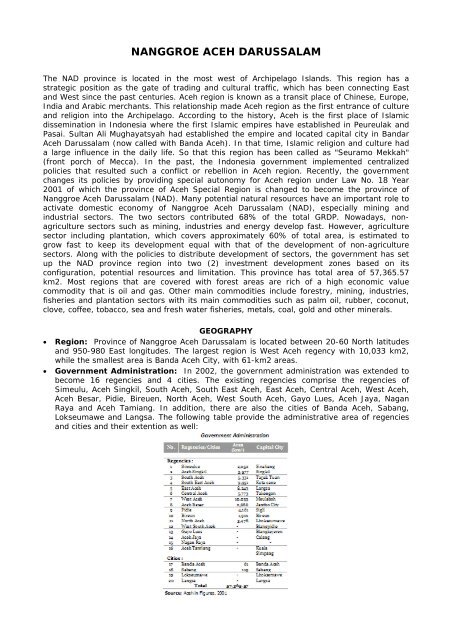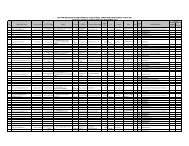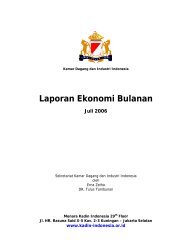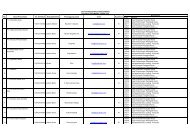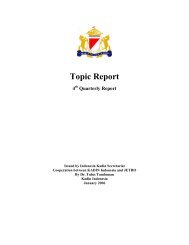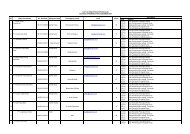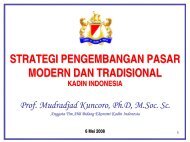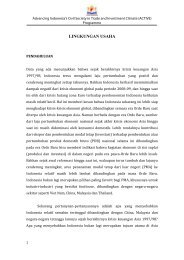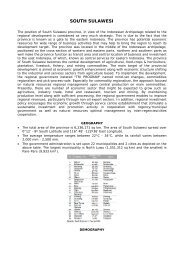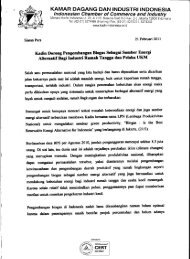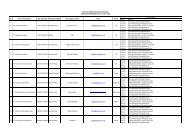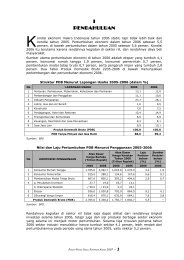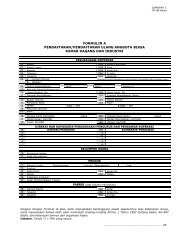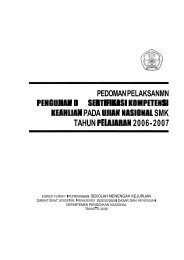NANGGROE ACEH DARUSSALAM - Kadin Indonesia
NANGGROE ACEH DARUSSALAM - Kadin Indonesia
NANGGROE ACEH DARUSSALAM - Kadin Indonesia
You also want an ePaper? Increase the reach of your titles
YUMPU automatically turns print PDFs into web optimized ePapers that Google loves.
<strong>NANGGROE</strong> <strong>ACEH</strong> <strong>DARUSSALAM</strong><br />
The NAD province is located in the most west of Archipelago Islands. This region has a<br />
strategic position as the gate of trading and cultural traffic, which has been connecting East<br />
and West since the past centuries. Aceh region is known as a transit place of Chinese, Europe,<br />
India and Arabic merchants. This relationship made Aceh region as the first entrance of culture<br />
and religion into the Archipelago. According to the history, Aceh is the first place of Islamic<br />
dissemination in <strong>Indonesia</strong> where the first Islamic empires have established in Peureulak and<br />
Pasai. Sultan Ali Mughayatsyah had established the empire and located capital city in Bandar<br />
Aceh Darussalam (now called with Banda Aceh). In that time, Islamic religion and culture had<br />
a large influence in the daily life. So that this region has been called as "Seuramo Mekkah"<br />
(front porch of Mecca). In the past, the <strong>Indonesia</strong> government implemented centralized<br />
policies that resulted such a conflict or rebellion in Aceh region. Recently, the government<br />
changes its policies by providing special autonomy for Aceh region under Law No. 18 Year<br />
2001 of which the province of Aceh Special Region is changed to become the province of<br />
Nanggroe Aceh Darussalam (NAD). Many potential natural resources have an important role to<br />
activate domestic economy of Nanggroe Aceh Darussalam (NAD), especially mining and<br />
industrial sectors. The two sectors contributed 68% of the total GRDP. Nowadays, nonagriculture<br />
sectors such as mining, industries and energy develop fast. However, agriculture<br />
sector including plantation, which covers approximately 60% of total area, is estimated to<br />
grow fast to keep its development equal with that of the development of non-agriculture<br />
sectors. Along with the policies to distribute development of sectors, the government has set<br />
up the NAD province region into two (2) investment development zones based on its<br />
configuration, potential resources and limitation. This province has total area of 57,365.57<br />
km2. Most regions that are covered with forest areas are rich of a high economic value<br />
commodity that is oil and gas. Other main commodities include forestry, mining, industries,<br />
fisheries and plantation sectors with its main commodities such as palm oil, rubber, coconut,<br />
clove, coffee, tobacco, sea and fresh water fisheries, metals, coal, gold and other minerals.<br />
GEOGRAPHY<br />
• Region: Province of Nanggroe Aceh Darussalam is located between 20-60 North latitudes<br />
and 950-980 East longitudes. The largest region is West Aceh regency with 10,033 km2,<br />
while the smallest area is Banda Aceh City, with 61-km2 areas.<br />
• Government Administration: In 2002, the government administration was extended to<br />
become 16 regencies and 4 cities. The existing regencies comprise the regencies of<br />
Simeulu, Aceh Singkil, South Aceh, South East Aceh, East Aceh, Central Aceh, West Aceh,<br />
Aceh Besar, Pidie, Bireuen, North Aceh, West South Aceh, Gayo Lues, Aceh Jaya, Nagan<br />
Raya and Aceh Tamiang. In addition, there are also the cities of Banda Aceh, Sabang,<br />
Lokseumawe and Langsa. The following table provide the administrative area of regencies<br />
and cities and their extention as well:
• Rainfall: The average annual rainfall is 1000-2000 mm with the average temperature is<br />
around 23.30C - 31.2 0C.<br />
DEMOGRAPHY<br />
• Population: In 2001, population reached 4,144,500 inhabitants, comprised 2,072,000<br />
(49,94 %) male and 2,072,500 (50.06%) female. The most densely populated area was<br />
Banda Aceh regency (400 people/km2), while the most rarely population was in Central<br />
Aceh city (20 people/km2)<br />
• Population Growth: In 2001, the annual population rate increased 2.72 % compared to it<br />
was in the previous year.<br />
• Labour Force: In 2001, the labour force reached 1,751,300 people (41%) from the total<br />
population. While the fully unemployment or people who were looking for a job reached as<br />
much as 98,853 people (2.38 %).<br />
THE ECONOMY<br />
• Gross Regional Domestic Products: In 2001, the GRDP of NAD province was amounted<br />
to Rp 6,193.9 billion. The most shares were contributed by agriculture sectors (40.94%),<br />
followed by transportation and telecommunication (15.17%), processing industries<br />
(11.49%), trading, hotels and restaurants (10.87%) and building/ construction (6.18%).<br />
The remaining sectors such as finance, leasing, business services, electricity and drinking<br />
water contributed lees than 5 percent.<br />
• Export and Import: In2001, the export value was recorded US$ 6,378,051.00,<br />
contributed by oil and gas as well as non-oil and gas commodities. Meanwhile, the import<br />
value was amounted to US$ 8,128,861,000.00 consisted of capital goods, components, raw<br />
materials and consumption goods.<br />
• Income Per Capita: In 2001, the average income per capita reached Rp 3,359,052.00.<br />
• Economic Growth: In 2001, the average economic growth of all sectors reached 1.56%.<br />
This figure was better compared those was reached in the previous year at 1.33 percent.<br />
• Minimum Wage Rates: In 2001, the average regional minimum wage rates were<br />
amounted to Rp. 216,000.00 per month
NATURAL RESOURCES<br />
• Farming (Agriculture): In 2001, the food crop area was approximately 360,640 ha,<br />
covered 79,090 ha technical irrigated fields, 98,650 ha semi technical irrigated fields and<br />
122,379 ha fields depending on the rainfall. There are only 226,722 ha irrigated field in this<br />
province. However, the average annual harvesting area reached 326,036 ha, contributed by<br />
the average production of the area that reached 4.2 ton per hectare.<br />
• Plantation: The plantation area reached around 209,435 ha. In 2000, the main<br />
commodities production covered: palm oil with production of 285,662 ton CPO and 53,852<br />
ton kernel, rubber production of 26,479 ha area and coffee of 99,434 ha area.<br />
• Fisheries: In 2000, the potential area of sea waters reached 33,000 km2 with fish<br />
production of 173,045 ton.<br />
• Forestry: In 2001, the area of cultivation forests reached 3,547,913 ha, consisted of<br />
conservation forests including protected forests and tourism forests with the area of<br />
2,141,783 ha (41,6%), national park of Leuser Mount with area of 666,800 ha, fixed<br />
production forests with the area of 592,280 ha, limited production forests with the area of<br />
813,850 ha and production forests with the area of 1,406,130 ha.<br />
• Animal Husbandry: In 2001, the main production of large, medium and small farming<br />
was relatively stable. The regional government has supported the effort to develop farming<br />
of which it resulted a better condition to the cattle businesses in this region.<br />
• Mining: In 2001, the main products of mining sector covered cement and liquid natural<br />
gas (LNG). Other minerals such as limestone, clay and sand were only benefited to fulfil raw<br />
material needs. Up to now, LNG has become the prime commodity because the most<br />
products have been provided to fulfil the export market.
INFRASTRUCTURE<br />
• Land Road: In 2001, the road network covered 15,202.08 km length, comprised 1,144.02<br />
km State road, 2,511.26 km provincial road and 11,546.80 km local (regency/ city) road.<br />
• Airport: In 2001, NAD province had 7 airports An 1 airport that is Sultan Iskandar Muda<br />
airport, is classified into international airport with 2,500 m runway. Meanwhile, other<br />
airports can only serve Fokker 27 airplane or other series. In 2001, passenger flow was<br />
recorded as 43,423 people arrived and 43,724 people departed.<br />
• Seaport: In 2002, there were 8 ports in NAD province. The most important port is<br />
Lhokseumawe port with 1,320 m pier that can serve 10,000 DWT ships
• Telecommunication: There are 88,740 fixed lines that reached almost all regencies/cities<br />
in this province. The connecting lines are amounted to 79,930 lines as indicated in the<br />
following table :<br />
• Energy and Electricity: In 2001, NAD province had 168 units of power generations by<br />
Diesel powered generation with the capacity of 260 Mw and Hydropower generation with<br />
the capacity of 2 Mw. The installed capacity of PT. PLN (Persero) (State electricity<br />
enterprises) reached 157.396 MWh. In addition, the government provided electricity from<br />
private companies with the capacity of 476,775 MWh of which 511,888 MWh has been<br />
distributed.<br />
• Clean (drinking water): In 2002, from the existing region, amounted to 13<br />
regencies/cities provided the clean/drinking water treatment with the capacity of 1,887<br />
litter/second. The recorded consumption reached 290.87 litter/second. The lowest capacity<br />
was provided by the installation of Aceh Singkil regency (10 liter/second) and the highest<br />
capacity was provided by the installation of Banda Aceh city (943 litter/second). The<br />
average capacity supplied by water installation in all regions reached 60 litter/second,<br />
except in Sabang installation that only reached 40 litter/second.<br />
SUPPORTING INFRASTRUCTURE<br />
• Banks and Insurances: At this moment, NAD province has 6 State banks, 2 private<br />
banks with 29 offices and 5 insurance companies with 9 branches.<br />
• Hotels: In 2000, there were 673 beds of star hotels and 134 non-star hotels with capacity<br />
of 2,261 beds.<br />
• Health Facilities: Many health facilities were available in the province such as 13<br />
governmental hospitals with 1,388 beds, 13 private hospitals with 773 beds, 218 Public
health centres with 75 beds, 6 private laboratories located in 4 regencies and 1<br />
governmental laboratory.<br />
• Education and Training: In 2002, education and training facilities covered 3,227<br />
elementary schools, 528 junior high schools, 215 senior high schools, 50 vocational schools,<br />
46 universities and 2 training courses.<br />
• Trade Centres: A shopping centre/supermarket is available in Banda Aceh city. In<br />
addition, there are 21 traditional markets spread out all over regencies/ cities. There are<br />
allow 5 traditional markets are located in 5 districts.<br />
DEVELOPMENT PLANNING<br />
In 2004 Annual Budget, the planned infra-structure development will cover the development of<br />
telecommunication networks with the capacity of 110,000 lines and land road of Ladia-Galaska<br />
which will be connecting South Aceh regency, South East Aceh regency and Gayo Lues. It will<br />
also cover the extention of (Rambee) Takengon runway to become 850 x 30 m of which it can<br />
serve F-28 series, and Kutacene airport runway in South East Aceh as well as Singkil airport so<br />
that it can serve CN 235 series. In addition, the government will develop seaport in Ulee<br />
Lheue.<br />
INVESTMENT OPPORTUNITIES


